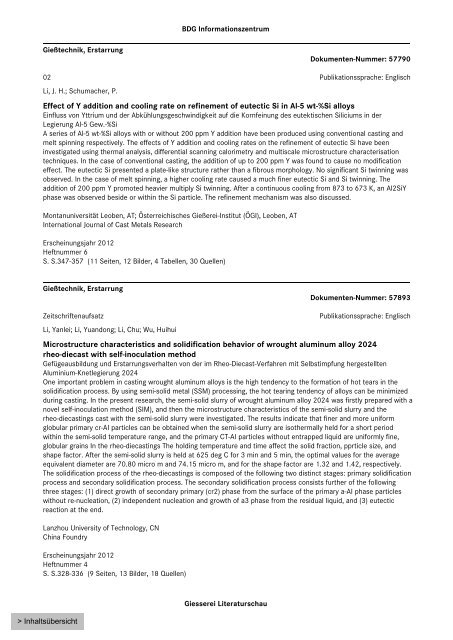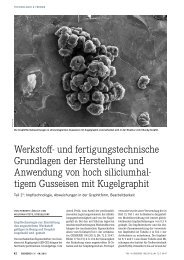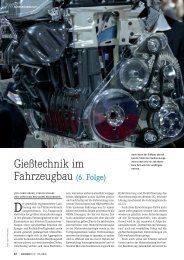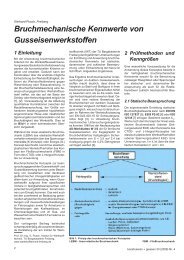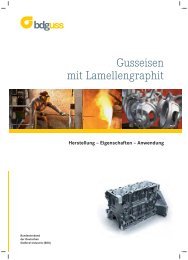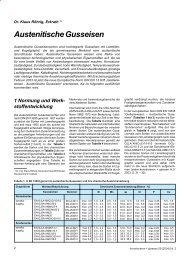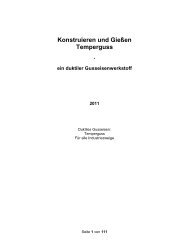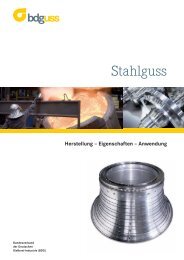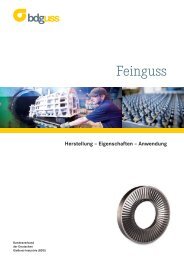Giesserei Literaturschau - Bundesverband der Deutschen Gießerei ...
Giesserei Literaturschau - Bundesverband der Deutschen Gießerei ...
Giesserei Literaturschau - Bundesverband der Deutschen Gießerei ...
Erfolgreiche ePaper selbst erstellen
Machen Sie aus Ihren PDF Publikationen ein blätterbares Flipbook mit unserer einzigartigen Google optimierten e-Paper Software.
BDG Informationszentrum<br />
Gießtechnik, Erstarrung<br />
Dokumenten-Nummer: 57790<br />
02 Publikationssprache: Englisch<br />
Li, J. H.; Schumacher, P.<br />
Effect of Y addition and cooling rate on refinement of eutectic Si in Al-5 wt-%Si alloys<br />
Einfluss von Yttrium und <strong>der</strong> Abkühlungsgeschwindigkeit auf die Kornfeinung des eutektischen Siliciums in <strong>der</strong><br />
Legierung Al-5 Gew.-%Si<br />
A series of Al-5 wt-%Si alloys with or without 200 ppm Y addition have been produced using conventional casting and<br />
melt spinning respectively. The effects of Y addition and cooling rates on the refinement of eutectic Si have been<br />
investigated using thermal analysis, differential scanning calorimetry and multiscale microstructure characterisation<br />
techniques. In the case of conventional casting, the addition of up to 200 ppm Y was found to cause no modification<br />
effect. The eutectic Si presented a plate-like structure rather than a fibrous morphology. No significant Si twinning was<br />
observed. In the case of melt spinning, a higher cooling rate caused a much finer eutectic Si and Si twinning. The<br />
addition of 200 ppm Y promoted heavier multiply Si twinning. After a continuous cooling from 873 to 673 K, an Al2SiY<br />
phase was observed beside or within the Si particle. The refinement mechanism was also discussed.<br />
Montanuniversität Leoben, AT; Österreichisches Gießerei-Institut (ÖGI), Leoben, AT<br />
International Journal of Cast Metals Research<br />
Erscheinungsjahr 2012<br />
Heftnummer 6<br />
S. S.347-357 (11 Seiten, 12 Bil<strong>der</strong>, 4 Tabellen, 30 Quellen)<br />
Gießtechnik, Erstarrung<br />
Dokumenten-Nummer: 57893<br />
Zeitschriftenaufsatz<br />
Li, Yanlei; Li, Yuandong; Li, Chu; Wu, Huihui<br />
Publikationssprache: Englisch<br />
Microstructure characteristics and solidification behavior of wrought aluminum alloy 2024<br />
rheo-diecast with self-inoculation method<br />
Gefügeausbildung und Erstarrungsverhalten von <strong>der</strong> im Rheo-Diecast-Verfahren mit Selbstimpfung hergestellten<br />
Aluminium-Knetlegierung 2024<br />
One important problem in casting wrought aluminum alloys is the high tendency to the formation of hot tears in the<br />
solidification process. By using semi-solid metal (SSM) processing, the hot tearing tendency of alloys can be minimized<br />
during casting. In the present research, the semi-solid slurry of wrought aluminum alloy 2024 was firstly prepared with a<br />
novel self-inoculation method (SIM), and then the microstructure characteristics of the semi-solid slurry and the<br />
rheo-diecastings cast with the semi-solid slurry were investigated. The results indicate that finer and more uniform<br />
globular primary cr-AI particles can be obtained when the semi-solid slurry are isothermally held for a short period<br />
within the semi-solid temperature range, and the primary CT-AI particles without entrapped liquid are uniformly fine,<br />
globular grains In the rheo-diecastings The holding temperature and time affect the solid fraction, pprticle size, and<br />
shape factor. After the semi-solid slurry is held at 625 deg C for 3 min and 5 min, the optimal values for the average<br />
equivalent diameter are 70.80 micro m and 74.15 micro m, and for the shape factor are 1.32 and 1.42, respectively.<br />
The solidification process of the rheo-diecastings is composed of the following two distinct stages: primary solidification<br />
process and secondary solidification process. The secondary solidification process consists further of the following<br />
three stages: (1) direct growth of secondary primary (cr2) phase from the surface of the primary a-AI phase particles<br />
without re-nucleation, (2) independent nucleation and growth of a3 phase from the residual liquid, and (3) eutectic<br />
reaction at the end.<br />
Lanzhou University of Technology, CN<br />
China Foundry<br />
Erscheinungsjahr 2012<br />
Heftnummer 4<br />
S. S.328-336 (9 Seiten, 13 Bil<strong>der</strong>, 18 Quellen)<br />
<strong>Giesserei</strong> <strong>Literaturschau</strong>


